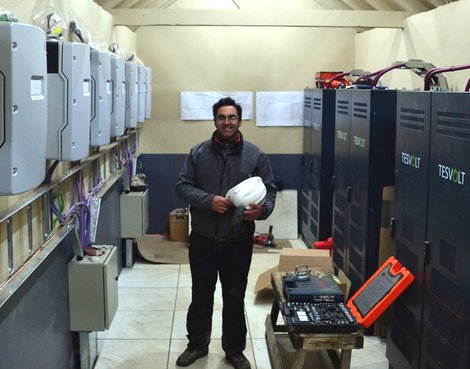First Hydroelectric-Solar Microgrid in Patagonia

Tesvolt delivers storage system for Patagonia National Park
A “run-of-the-river” hydroelectric power station, photovoltaic installation, and battery storage system have been combined to provide facilities in the Patagonia National Park with electricity from renewable energy sources. The park is part of one of the most important nature conservation projects in the world. It was established by the founder of North Face, Douglas Tompkins, and his wife Kristine, previously CEO of the outdoor clothing company Patagonia. The aim of their foundation, Tompkins Conservation, is to rewild the region after decades of heavy overgrazing and desertification.
Renewable energy for outstanding nature conservation project
The Patagonia National Park is one of the most important nature conservation projects in the world. It owes its existence to the vision and financial means of Douglas and Kristine Tompkins. The two Americans moved to Chile in the early 1990s to push for the preservation of some of the most impressive wild landscapes in the world. Together, they helped create and extend 15 national parks in Chile and Argentina and eventually worked with both governments to protect over 14 million hectares of land.
The Patagonia National Park is located an enormous distance from the nearest public utility grid. The power requirements of the park’s facilities have to date been provided by diesel generators – an expensive and environmentally damaging solution.
“Combining run-of-the-river hydroelectric power and a photovoltaic installation is technically very demanding,” explains Gonzalo Rodriguez, engineer at the Patagonian installation company SyR Energía who planned and executed the project. To achieve a total output of 115 kilowatts peak (kWp), two hydraulic turbines were combined with a solar system, both with AC coupling. The lithium-ion battery storage units have a capacity of 144 kilowatt hours (kWh).
In winter and spring, the Patagonian rivers are swollen by heavy rainfall and snowmelt from the Andes. The two micro-turbines convert the energy from the water into electricity. In summer, the water level in the rivers drops significantly and the required electricity is then supplied by the photovoltaic installation. Excess electricity is temporarily stored in the battery storage systems from the German manufacturer Tesvolt.
Sustainable tourism in a natural paradise
The Patagonia park encompasses over 300,000 hectares of grassland plateaus, forests, wetlands and alpine regions. As with the majority of the region, intensive livestock farming on sandy, dry ground in the Chacabuco valley has resulted in extensive desertification. Since purchasing the area in 2004, the Tompkins Foundation has been committed to restoring the original grassland and establishing native plant and animal species. The Estancia Valle Chacabuco sustainable hostel, a restaurant, camping sites, hiking trails, and an information centre and museum allow tourists to immerse themselves in nature and take a vacation with minimum environmental impact. Tompkins Conservation donated the park to the Chilean state and today, the park is maintained by the Chilean National Forestry Corporation (CONAF).
“We are very excited about the construction of the most advanced hydroelectric-solar microgrid in Chile which will continue to provide clean power for the park for many years to come. This alternative energy system minimises the park’s CO2 footprint and therefore contributes to the fight against climate change,” says Carolina Morgado, Executive Director of Tompkins Conservation Chile.
Hydroelectric-photovoltaic storage system runs faultlessly
“The park is so remote that it was extremely important to install installation components of high quality that therefore require minimum maintenance,” explains Rodriguez. “We therefore decided to install storage systems from Tesvolt who lead the field in terms of quality. This has paid off. The installation has now been running without no problems at all for exactly one year.”
Tesvolt specialises in battery storage system solutions for trade and industry. Thanks to the company’s own intelligent battery control, Tesvolt storage systems operate with outstanding efficiency and have a long expected lifespan of 30 years. They are also exceptionally safe thanks to system control down to the cell level.
Source: www.tesvolt.com

